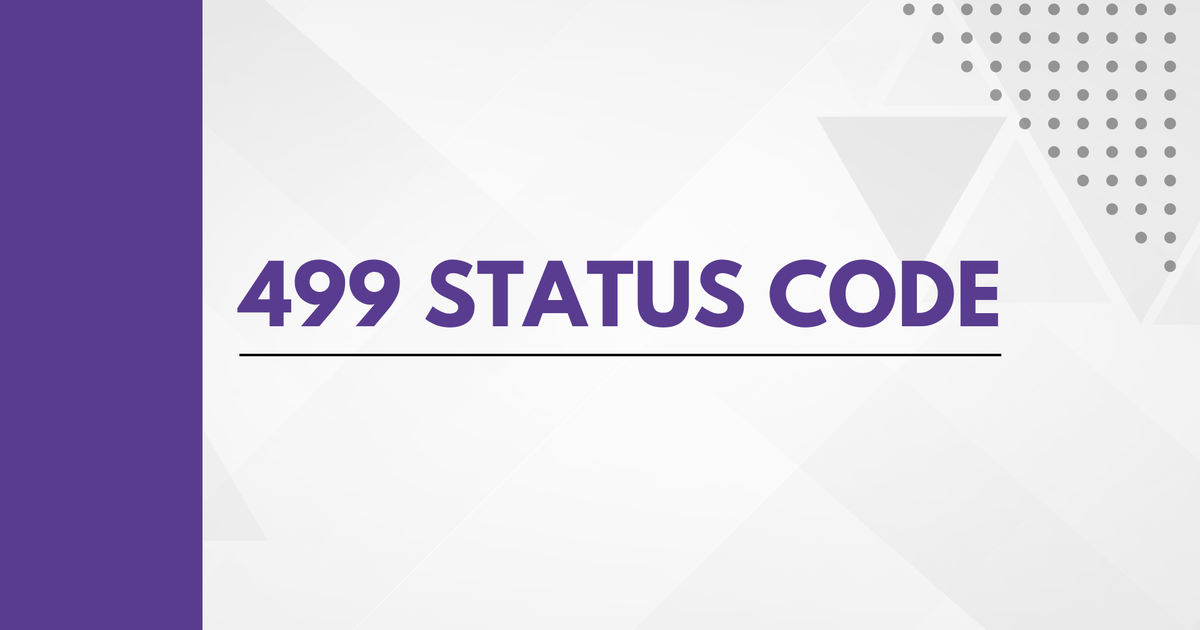499 Status Code
HTTP Status Code 499, unique to nginx, indicates a client closed the request before a server response. Learn about this non-standard code.


- 499 status code example
- Root causes of a 499 Status Code
- Troubleshooting a 499 Status Code
- Does a 499 status code affect SEO?
- Conclusion
The HTTP 499 status code isn’t part of the official HTTP/1.1 standards. Instead it’s specific to nginx web servers, used to signal that the client closed their connection before getting a response from the server.
This error often happens if a client stops the connection too soon, like canceling a request or leaving a webpage before it finishes loading. Sometimes, this error might also come up due to server or network problems that interrupt the link between the client and the server. For a deeper understanding of web server behaviors and troubleshooting, you might find the Google Crawl API insightful.
499 status code example
The 499 status code isn’t officially part of the HTTP status code list, but some servers use it to show that a client has ended the connection before getting a response. Below is an example of such a request and responses scenario:
Request
GET /index.html HTTP/1.1
Host: example.com
Response
HTTP/1.1 499 Client Closed RequestServer: nginx/1.19.6
Root causes of a 499 Status Code
The HTTP 499 error is unique to nginx web servers and happens when the client ends the connection before the server has a chance to reply. This can occur for various reasons, such as:
Network issues: If the network connection between the client and server is unstable, like if there’s a dropped connection or high latency, the connection might be lost before the server has the opportunity to respond.
Client-side issues: If the client leaves the page before it completely loads or cancels the request before the server has a chance to reply, the connection could be cut off before any response is delivered.
Server-side issues: If the server is facing problems, like being overloaded or improperly set up, it might not manage to answer the client’s request quickly enough.
Firewall or security software: If a firewall or security program is blocking the connection or disrupting the communication between the client and server, the connection might get lost.
Misconfigured server: If the server is set up incorrectly, it might struggle to process requests correctly, leading to a 499 error.
Server-side timeout: The server might be configured with a timeout for responses. If this time limit is exceeded, the server could close the connection, causing a 499 error.
These scenarios are just a few possibilities behind an HTTP 499 error. Pinpointing the exact cause might require a deeper investigation, possibly involving server logs or other troubleshooting techniques.
Troubleshooting a 499 Status Code
Troubleshooting the HTTP 499 error, which isn’t part of the standard HTTP status codes, can be challenging. Yet, you can follow some steps to identify and fix the problem:
- Check Server Logs: Look into the server logs around the time the HTTP 499 error appeared. These logs might offer hints on what triggered the error.
- Examine Network Connection: Make sure the connection between the client and server is stable. Look for network problems like dropped packets or high latency that could disrupt the connection.
- Clear Browser Cache: Empty the browser cache and delete cookies to rule out issues caused by outdated cached content or cookies.
- Turn Off Browser Extensions: Disable any browser extensions that might be affecting the connection, such as ad blockers or security tools.
- Use a Different Browser or Device: If the error continues, try accessing the site with a different browser or device to determine if the problem is with the original setup.
Does a 499 status code affect SEO?
Although the 499 status code isn’t officially part of HTTP status codes and might not be a frequent occurrence, its persistent presence on a website can still indirectly affect SEO. This is because ongoing issues with 499 errors could harm the user experience, potentially resulting in decreased engagement and increased bounce rates. Such negative user interaction signals can indirectly influence your site’s SEO performance. To understand the full impact of server errors on SEO, you may want to explore the Google SERP API for more insights.
Conclusion
In summary, the HTTP 499 status code, unique to nginx web servers, indicates that a client has ended the connection too early, before a response could be sent. While it’s not included in the standard set of HTTP codes, it’s typically triggered by problems with the client, network distributions, or server configurations.
To tackle this, you should look into server logs, check the network’s reliability, and address any browser issues. Even though it’s uncommon, ongoing 499 errors could indirectly harm SEO by deteriorating the user experience. This highlights the importance of quickly addressing these errors to ensure a smooth website experience and avoid any negative effects on SEO.